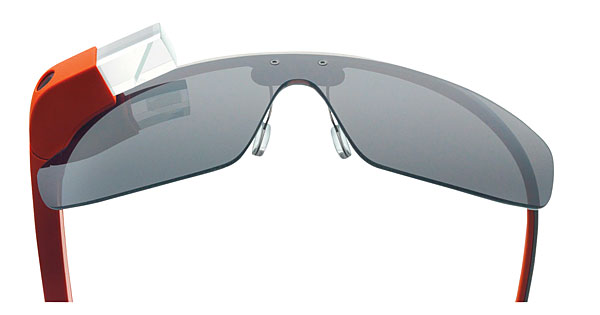The notion of people walking around with little cameras aimed at you freaks me out. I can't be the only one. Imagine having someone holding up their cellphone camera at you while talking to you. This is so remarkably intrusive I can't believe it's not being discussed more. If I had a friend wearing these while talking to me I'd insist that he take them off. It's beyond obnoxious.
Google Glass: Running with Screens—Or Not

Glass includes a 5-megapixel camera and 720p video recorder. Audio is delivered through a bone conduction transducer. The frame contains 16 gigabytes of flash memory, and it embeds both Bluetooth and Wi-Fi connectivity. Glass can operate for a full day on a single battery charge, and it comes with a micro USB cable and charger. Intriguingly, there’s a tiny square display in the upper right corner that the wearer perceives as a 25-inch high-definition screen 8 feet away.
With Glass ($1,500) targeted initially at developers, the digital wags have been lobbing a frenzy of desires and prejudices onto the device. A criticism is the jeopardy to users and nearby souls that results from hanging a display off of one’s face. News flash: It’s already impossible to walk on an urban sidewalk or through a mall without being party to collisions between people so fixated on their smartphones that they’re oblivious to near-field reality. Maybe a heads-up display in their peripheral vision would actually lessen the threat.
There are different ways to use the display, though the one that makes most sense is to superimpose information on what you’re actually looking at, be it a diagram overlaying a machine, a map of the street you’re on, or translation of a foreign-language sign. Rather than forcing the opaqueness of virtual reality, Glass is meant to deliver the transparency of enhanced reality.
As with a music player, a personal display might appeal to someone strolling or jogging through the park. If a developer can combine a mobile/handheld TV receiver that takes advantage of the ATSC-M/H signals already being broadcast by some DTV stations, I’d have the opportunity to watch the local news in the corner of my eye as I rounded the Central Park Reservoir. Others might choose a sports event or talk show. On a bright day, I wouldn’t mind an option to darken the sky a bit to better discern Katie’s legs. Think of it as an ambient light sensor on the back of the TV—or incremental translucency control or simply sunglasses on steroids.

What’s missing from Glass is an A/V input for attaching a video source component. But who needs cables when entertainment and information act wirelessly? Even if you could, would you really want to store movies in the eyewear’s internal memory? Those built-in Wi-Fi and Bluetooth connections are perhaps all you need for streaming any content, if not from the cloud, then from a wireless flash drive you’re carrying. In runner’s shorts, you are your own hot spot.
A real value of Glass, however, could be tapped not while the device is mobile but when it’s used within the home. And I don’t mean as a display replacement, but as a wearable filter to the big TV that is your primary display. Imagine watching Django Unchained in your home theater. Halfway into the Tarantino spaghetti western, a particular actor looks familiar or maybe you’ve lost the threads of the plot. No problem. Touch the frame to activate Glass’s camera and use its facial recognition technology to identify Samuel L. Jackson and the controversial character he plays. Touch it again, and leverage the movie’s elapsed time to reveal the plot so far—a summary that doesn’t spoil the rest of the film. Now, that’s technology I could use, particularly when I haven’t gotten enough sleep. Another application could be personalized captions for the hearing-impaired or alternate-language text that appears on a specific Glass pair so that one viewer’s preferences don’t necessarily impinge on someone else’s. Can we all get along on the couch?
Since it’s only 2013, we’re left to mainly project how we think a device like Glass will evolve. But speculation can lead to great things. The bottom line is that thanks to this new category of wearable, intelligent electronics and the apps and accessories sure to come, it’s patently clear that glasses are no longer just for corrective vision or 3D anymore.
- Log in or register to post comments




















































